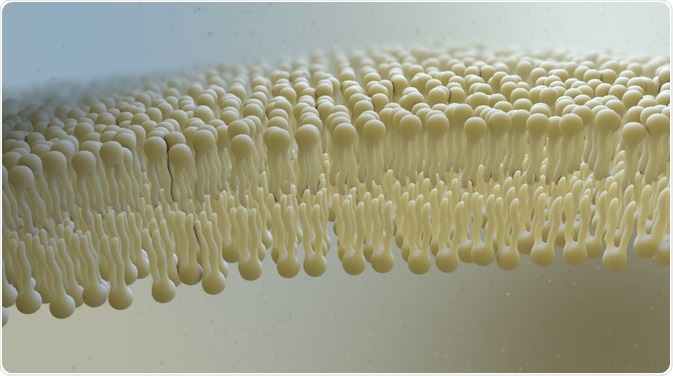Lipids are one of the major components that play a key role in the maintenance of human health. Lipidomics focuses on the study of molecular lipids in biological systems, which include cells, tissues, and biofluids.

Lipid Bilayer. Image Credit: Nathan Devery/Shutterstock.com
Among metabolomics technologies, scientists are greatly intrigued by lipidomics because of the varied applicability of lipids in nutrition that have both direct and indirect roles in human health. In food science research, lipidomics is effectively used to interpret the interaction between diet, human metabolism, and nutrients.
Researchers use lipidomics to understand health benefits associated with food habits and also aim to optimize the effects of food processing on dietary benefits. With the advancements in analytical tools such as mass-spectrometry, bioinformatics, etc., scientists can structurally identify several hundreds of lipids with high throughput resolution and sensitivity.
What is Lipidomics?
Lipidomics first emerged in 2003 and deals with the study of the entire lipid content of a cell, which is known as a lipidome. The first generation of lipidomics study has proved its ability to bring about a revolution in life science research. Some of the areas where lipidomics study has contributed significantly are discussed below:
- The complete analysis of all lipid constituents in a biological sample.
- Characterization of lipids at their molecular level.
- Determination of specific genes that encode proteins that are responsible for lipid metabolism.
- Quantitative and molecular measurements of lipids.
- Comprehensive understanding of biological processes.
- Development of diagnostic tools for various diseases.
- Identification of microbial contamination.
- Determination of dietary actions.
- Detection of new signaling pathways.
- Study of cellular compartments.
- Analysis of disease mechanisms.
- Identification of toxicological targets and their mechanisms.
- The understanding of the molecular mechanisms that are responsible for metabolic diseases.
In general, the pace of success in lipidomics is slow. This is because lipids are connected to enzymatic reactions. Further, as they are included in regular diets and metabolism, in vivo studies including lipids exhibit a high rate of variation within individuals and across organisms. Scientists claim that accurate measurements of all lipids within an individual will potentially revolutionize food science research.
Mass spectrometry (MS) in Lipidomics
As stated before, lipidomics has gained momentum with the development of Mass spectrometry (MS)-based lipidomics techniques. Some of the commonly used techniques are as follows:
- Liquid-chromatography coupled MS
- Shotgun lipidomics
- MS imaging
- Ion-mobility MS
The Role of Lipidomics in Food Science Research
Several researchers have reported the importance of diet in the overall metabolism of lipids in both humans and animals. The main importance of nutritional lipidomics is to evaluate the diet-dependent changes in the composition, function, and structure of cellular lipids. In the research associated with nutrition, lipidomics can help understand the function of lipids as a signaling molecule, and their role in metabolic pathways.
Lipidomics also helps to elucidate the relations between nutrients and human metabolism. Another important highlight of lipidomics research is its ability to determine the dietary intake of an individual in a standardized manner in a way that it can precisely analyze the mild to chronic effects of dietary components. Such insights would help design a proper diet chart to promote a lifelong healthy life. More recently, a lipidomics study has shown the underlying molecular mechanism associated with the health benefits of dietary ω-3 polyunsaturated fatty acids. It has also evaluated the regulatory role of ω-3 and -6 fatty acids in the inflammatory response.
Currently, researchers are applying lipidomics to determine the changes in the quality of chilled beef loins which have been sterilized using irradiation techniques. Sterilization by irradiation is considered as one of the important cold sterilization techniques and is widely used for the sterilization of food such as spices, frozen meat, dehydrated vegetables, etc. This technique is not used for high fat-containing food as it releases a bad odor owing to the oxidation of fats.
However, a high-energy electronic eradiating accelerator could efficiently sterilize such high fat-containing food without fat oxidation. In this study, the scientists have used lipidomics analysis to provide strong proof for the variation in the quality of lipid contents between the sterilization processes.
Lipidomics has been used to analyze infant formulas. In a survey, it has been estimated that in the United States alone two-thirds of infants receive infant formula milk as a primary nutrition source during the first six months of their life. Recently, scientists have analyzed oxidative and non-oxidative lipidomics profiles of several commercially available infant formulas.
The lipidomic fingerprint of the liquid infant formulas showed the presence of an oxidated form of cholesterol (7-ketocholesterol), and a low level of phytosterols. Such data helped the researchers establish a new classification of infant formulas based on their metabolomic fingerprint.
Another interesting application of lipidomics is its utilization as a clinical tool for monitoring metabolic changes in an individual’s health. The category of lipid that shows the highest percentage of inheritance is phospholipids. These lipids are also linked with heritable disease risks. As a change in nutrition can alter the lipid profiles, more work is needed to understand how to prevent the onset of these diseases.
Further Reading